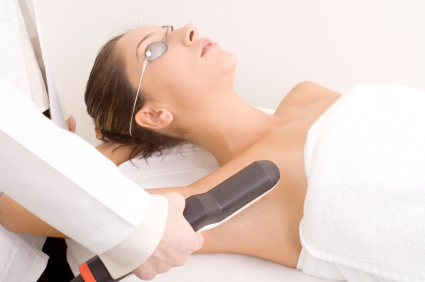Your skin doesn’t have to resemble a moon crater, crumpled clothing, or a spotty Dalmatian. Now, there is an innovative way of reducing the ugly marks left by acne, or the lines that accompany aging, and the dark spots that ruin your looks.
Fractional laser resurfacing or fractional thermolysis is a new method of skin rejuvenation that was commercially introduced since 2003. What sets this apart from other laser resurfacing methods is that it only treats a fraction of the skin, leaving the surrounding areas alone.
thermolysis is a new method of skin rejuvenation that was commercially introduced since 2003. What sets this apart from other laser resurfacing methods is that it only treats a fraction of the skin, leaving the surrounding areas alone.
This allows a faster or virtually no downtime than the earlier laser technologies.
How Does Fractional Laser Resurfacing Work?
A fractional approach to resurfacing means that only specific areas are targeted using lights that are delivered in small, closely spaced micro beams. Both the epidermis and dermis are penetrated. Only a small proportion of the skin receives the laser light, while the other zones in between are left intact.
This way, the skin heals much faster because only fractional damage was caused by the heat of the light source. The micro injured cells start the process of healing with collagen remodeling. The healthy unaffected tissues help to fill in the damaged area with new cells.
The skin tightens and its texture improves. The treatment is comparable to a pixel by pixel retouching of a digital photograph.
Some of the fractional laser systems commonly used are Fraxel, Active Fx, Palomar Starlux 1540, Pixel CO2, PROFractional Erbium, Pearl Laser, Juvia, and Affirm.
Skin Conditions that can be treated with Fractional Laser Resurfacing
- Wrinkles
- Acne scars
- Traumatic scars
- Sun damage
- Brown spots
Contraindications/ Precautions
People with a history of skin sensitivity to light, or have an active infection near the site to be treated are not allowed to undergo the fractional laser resurfacing. The use of retinoids for acne treatment within the past 12 months is also contraindicated.
Darker skin types must be properly evaluated by a doctor because of some issues of fractional lasers with these skin groups. Ethnic skin has a tendency to develop hyper pigmentation post fractional laser resurfacing. Your physician may recommend an adjunctive regimen to help counter this unpleasant effect.
Pregnant or breastfeeding mothers should delay the treatment because the safety of the fractional laser resurfacing on them is still not well- established.
The Treatment Process
The process is reported to be well tolerated by most patients. There may be some mild prickling or burning sensation. An anaesthetic cream may be applied on you skin prior to the fractional laser resurfacng to reduce any pain or discomfort.
The fractional laser resurfacing will vary depending on the specific device used. The need for cooling systems, gels, optical dyes, solutions will likewise be dependent on the type of laser system. Generally, fractional laser resurfacing is finished in less than 30 minutes.
Post Treatment
You can return to your usual activities after the session but for the first week your skin may be red and swollen. There may be a sunburn sensation lasting for a few hours to a few days. Cooling gels may be applied to relieve the discomfort.
For most fractional laser resurfacing systems, make-up can be used immediately to camouflage the redness. Flaking can occur in 4 to 7 days. Your skin will be extremely sensitive to light, so avoid basking in the sun during this period. Sunscreens with high SPF will be useful.
Usually, multiple sessions are required for optimal results. Around 3 to 5 treatments are necessary, with 5 to 7 days interval. The exact number of treatments you will need will be determined by your plastic surgeon.
Dramatic improvements of the skin condition are typically observed in 2 to 3 months. The effects are lasting but not permanent. If you’d rather have a single yet more permanent solution, plastic surgery is an option. Face lifts, for example, will tighten the skin to reduce wrinkles with more permanent results.
Cost of Fractional Laser Resurfacing
The cost per fractional laser resurfacing can vary from $800 to $2,500, so a complete package would range from $4,000 to $9,000. Cheaper alternatives are available as a treatment for acne scars, wrinkles and dark spots. You may want to look into skin treatments such as Chemical Peels, Microdermabrasions, and Collagen Injections.
All of these have their corresponding pros and cons. Discuss with your doctor regarding your options before deciding on what would suit you best.
